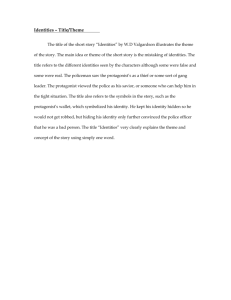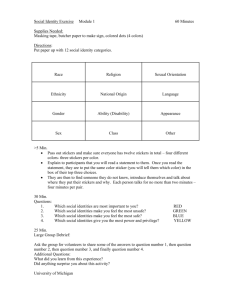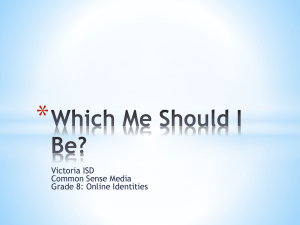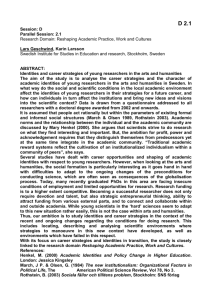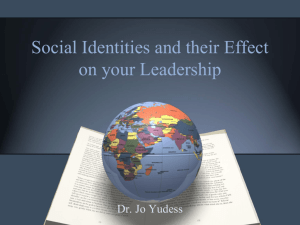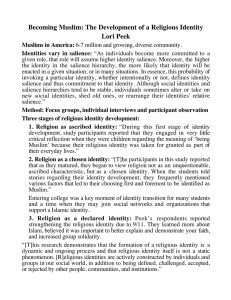Chapter 3
advertisement
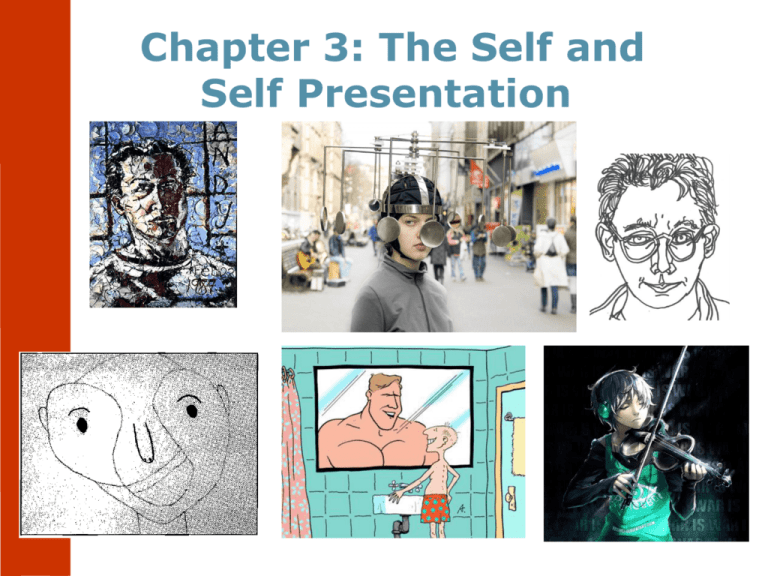
Chapter 3: The Self and Self Presentation •Email The Self What is the Self? http://www.youtube.com/watch?v=zGv1Nay2z-U Who Am I? Our answers reflect: – Self-schema – Self-concept – Thoughts about ourselves 3 The Nature & Origin of Self Symbolic Interaction Theory – Self is active – Self is passive William I. James & George H. Mead: – Active aspect of the self is the I. – Object of self-action is the me. 4 Steps in the Origin of Self 1. Self-Differentiation 2. Role Taking 5 Self-Differentiation Distinguish our faces and bodies from others –Not born with this ability –Acquire very quickly •18 to 24 months • Baby in bath – http://vimeo.com/2654937 6 Role Taking Imagine self from position of another person View self and situation from that person’s perspective 7 The Looking Glass Self • Charles Horton Cooley -Significant others - As child interacts with others, the number of significant others increases 8 Stages in the Development of Self Mead (1934) identified two sequential stages 1.Play Stage 2.Game Stage 9 Stages in Developing the Self #1 Play Stage–Young children imitate other people –Father –Mail carrier –Doctor… 10 #1 Play Stage 11 Stages in Developing the Self #2 Game Stage– – Complex activities – Playing house or school – Team sports –Imagine viewpoints of several others at the same time 12 #2 Game Stage 13 The Game Stage: Baseball 14 The Generalized Other - View of attitudes & expectations held by members of organized groups We imagine what a group expects of us –Taking role of generalized other 15 The Self We Know 1. Specific identities 2. Reactions of others 3. Varies with situation - Example: Communicate over internet Create identity May have multiple identities 16 Identities Meanings attached to self –Linked to social roles –Membership in groups 17 Role Identities Self in specific roles Develop a different view of who we are –an identity 18 Adoption of a Social Identity Involves socialization into the group of which the role is a part –Agents of socialization –Anticipatory socialization 19 Social Identities in Groups 20 Situated Self Self-concepts distinctive to the setting and Relevant to activities 21 Situated Self 22 Identities: The Self We Enact Enact behaviors that Evoke responses to Confirm particular identities 23 Hierarchy of Identities Importance of an identity varies from situation to situation – Organize identities into a hierarchy – According to their salience Importance of identity (salience) – More situations as opportunities to enact identity 24 Effects of Self-awareness http://www.youtube.com/watch?v=vA2cDV4K9jg Focusing on our own: –Appearance –Actions –Thoughts 25 Effects of Self-awareness Things that increase selfawareness –Mirrors –Pictures –Voice recording –Video clip 26 Assessing Self-Esteem Overall self-esteem –All identities Role Specific self-esteem –Individual identities 27 Self-esteem 28 Rosenberg’s Self-Esteem Scale 29 Sources of Self-Esteem Three sources: 1. Family Experiences: – – Acceptance Discipline 2. Performance Feedback: – Effectiveness of our actions 3. Social Comparison: – Successes and failures with those of others 30 Self Presentation Varies situation to situation: (Examples) – To parents, as good son or daughter – To friends, as “cool“ and “with it” – At a bar, as old enough to be served drinks 31 Self-Disclosure Sharing our identity (s) with another Usually bilateral or reciprocal The “norm of reciprocity” –Sharing too much intimate information often weakens the relationship –May lead to disliking 32 Tactical Impression Management Conscious, goal-directed activity to control information To influence impressions Expression of emotions may be appropriate or inappropriate. – For example: – Service workers must conceal anger or fear – Surgeon expressing fear before operating on your child 33 Managing Appearances Impression an individual makes depends not only on clothes, makeup, and grooming But also on props in the environment 34 Managing Appearances Irving Goffman draws parallel between theater’s front and back stages & the regions we use in managing appearances. – Front Region – – Accessible to outsiders – Normative expectations – Back Region – – Settings inaccessible to outsiders where – one violates front region performances. 35 Ineffective Self-Presentations & Spoiled Identities Some recover when their identity is challenged Others have a permanently spoiled identity –Ex President Richard Nixon –Designer Martha Stewart 36 Cooling-Out and Saving Face Gently persuading a person whose performance is unsuitable to accept a less desirable, though still reasonable, alternative identity. – Example: Switching from pre-med to psychology Often causes identity degradation Offender becomes a non-person; One who can not be trusted to perform in the original role 37


